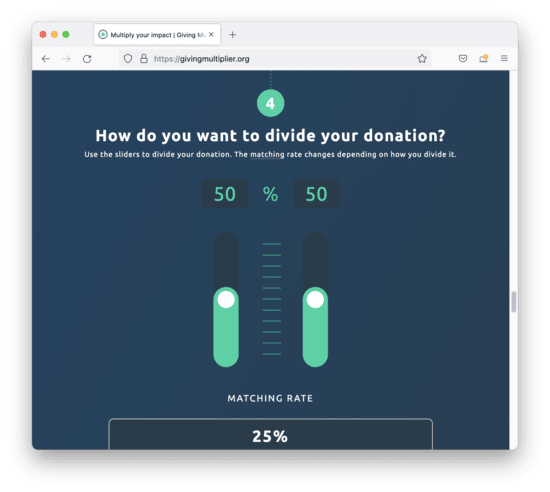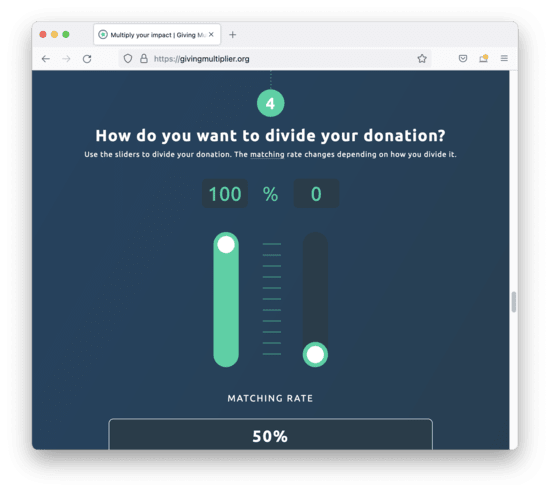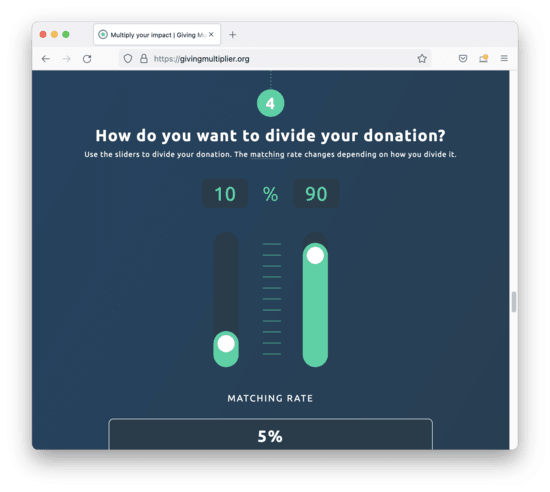See the end of this post for a response from Giving Multiplier.
Giving Multiplier launched last fall to promote effective giving. You may have read about it at the time in Future Perfect, but I learned about it more recently, from Giving What We Can. Since it aims to convince people to donate to excellent charities, many of which are GiveWell-recommended, you might expect I would be happy about this, unless you'd read last week's post about GiveWell's donation matching.
So: what is Giving Multiplier? You come in as a person who has a favorite charity in mind, and it suggests you split your donation between that charity and one of the charities it recommends.
First you select your favorite charity:
Then it asks you to choose one of its favorite highly effective charities:
It asks you how much you were thinking of donating, in this case $100:
It suggests splitting your donation 50-50, and offers to provide a 25% match if you do:
With the 25% match it shows a total donation of $125, $100 from you and $25 from its match, so $62.50 to each charity:
I read this as an offer: if you donate some of your money to both charities, so will it.
So, what's the problem? The general idea of convincing people to shift donations to effective charities is a good one, but this is convincing people by misleading them.
First, the site reads as if it will send matching funds to the charity of your choice, but really all of that money comes from you. Play with the sliders and you'll see that if you direct all the money to the effective charity then the match goes from 25% to 50%:
Go the other way, and you'll see it won't let you give less than 10% to the effective charity. At that point, the match is just 5%:
A simpler way to describe this is that it matches whatever portion you choose to give to the effective charity at 50%, and doesn't match your donation to the other charity at all:
| Proportion to Effective Charity | 10% | 50% | 100% |
|---|---|---|---|
| Proportion to Regular Charity | 90% | 50% | 0% |
| Offered Match Rate | 5% | 25% | 50% |
| Your Funds to Effective Charity | $5 | $42 | $100 |
| Your Funds to Regular Charity | $95 | $63 | $0 |
| Match Funds to Effective Charity | $5 | $21 | $50 |
| Match Funds to Regular Charity | $0 | $0 | $0 |
After reviewing a draft of this post, Giving Multiplier added a Transparency Page where they discuss this, and linked it in Step 4 as "Learn how our matching system works. It may be more complicated than you think." This is an improvement, but I still think the design of the site misleads users into thinking that by participating in Giving Multiplier matching funding will, on net, flow to their favorite charity.
That aside, while it claims to "multiply your impact", are you actually causing it to donate money that it wouldn't otherwise donate? Let's look at what it says to prospective funders on its Fund Us page:
If you would like to become a matching funder, please fill out the donation form below. All of your donations will go to charity. Your matching funds will be used for the current or subsequent donation cycle to match other people's donations. Any matching funds that are unused after 6 months will automatically be donated to effective charities.
The pool of matching funds is all going to go to effective charities, regardless of whether you or anyone else signs up to have your giving multiplied.
Now, your donation does likely encourage contributions from future matching funders: is that impact? It depends what those funders would do instead. Since it is drawing funding primarily from the effective altruism community, where people typically have funds they intend to donate and are looking for the most effective way to do so, I think this is unlikely to increase total donations from those funders.
On their new Transparency Page they do say "more than half of the donations going into our matching system are donations that, according to the donors, would not have gone to super-effective charities were it not for Giving Multiplier", but this is not the right counterfactual for the main users of Giving Multiplier. Imagine somebody goes to Giving Multiplier, learns about effective giving, and then decides to provide some money to the matching pool. They say "no" when asked something like "would you have donated this money to a highly effective charity if Giving Multiplier didn't exist", but that doesn't mean they would also say "no" to "would you donate this money to a highly effective charity if Giving Multiplier had to decline your offer of matching funds". Additionally, as discussed in last week's post on GiveWell's donation matching, I don't think asking users to confirm that their donation is counterfactual meets the standard of evidence we usually apply for impact claims in effective altruism.
The best case for donation matching is as a way to say that you think a charity's work is valuable enough that you're willing to put your money toward it in the hope that others will join you. A few years ago I offered a donation match on my blog, though I ended it with the clarification that it was "a donor illusion, in that you're not actually affecting the amount I give them this year."
On the other hand, Giving Multiplier influences donors by giving the impression that they are reallocating money through their choices when that's not actually happening. I don't think this is something we should be doing in effective altruism: it is more important to build a robust movement of people collaboratively and honestly maximizing impact than it is to move additional money to even very good charities in the short term.
(It is possible to use this platform to directly reallocate money if you have preferences among their "highly effective" charities, have money you were already planning to donate, and are willing to lie on forms. For example, say you think that animals matter much more than the typical donor does. You could move $X in matching funds from a mix of effective charities to specifically the Humane League, as long as you were already planning to donate $2X to the Humane League. Please don't do this.)
Lucius and Josh, the people behind Giving Multiplier, have done some great research on what motivates people to donate, how people think about giving, and how people with different moral views can coordinate. And donation matching with misleading claims of impact is very common in the nonprofit world. But it's because I respect them as researchers and as people trying to make the world better that I'm holding their work to a higher standard here.
I sent a draft of this post to Lucius and Josh, and made changes based on their feedback. They disagree with my interpretation here, and they asked me to include their response:
We thank Jeff for his comments. We have tried to be clear from the start about what Giving Multiplier does and does not offer users, and we believe that Giving Multiplier's users have understood its fundamental principles. However, in an effort to be as clear as possible, we have responded to Jeff's comments with the addition of a detailed transparency page.
Our transparency page addresses all of the issues raised by Jeff in this post, and we recommend that interested readers start there.
The transparency page is prominently linked on the home page in two places. In addition, we now require donors, before submitting their donation, to explicitly acknowledge (using a checkbox) that they understand that our matching funds are pre-paid. These measures ensure that our users understand how Giving Multiplier works and what it can and cannot offer them.
It seems to us that Jeff's post is partly rooted in a misunderstanding of why people use Giving Multiplier and what they believe they are doing when they use it. The purpose of Giving Multiplier is to introduce new people to effective giving. It is designed for people who like the idea of supporting *both* a personal favorite charity and a recommended highly effective charity. Giving Multiplier users are not—as this post seems to suggest—trying to use Giving Multiplier as a "money pump" for their personal favorite charities, but then failing to realize that this is not possible. The website says explicitly that this is not possible, and anyone who uses our donation interface will see that it's not possible: The amount supplied by the user is always visibly larger than the amount directed to the personal favorite charity, including matching funds. There is no ambiguity about this.
About a thousand donors have used Giving Multiplier so far—most of whom are new to effective giving. We have received hundreds of messages from donors who say that they love the idea of donating both to their favorite charity and a highly effective charity. Not a single user has said that they felt misled.
Contrary to what Jeff says in this post, Giving Multiplier's matching system offers donors additional value. As explained on our transparency page, this happens in two ways:
By directing matching funds to the specific charities that the users have selected: For example, suppose a donor wants to support both the Make-a-Wish Foundation (favorite charity) and The Humane League (super-effective charity). She could donate $50 to each charity directly. Or she could donate through Giving Multiplier and cause $62.50 to go to each charity. The added $25 in matching funds would otherwise go to various effective charities, but not the two specific charities she cares most about. Thus, her use of Giving Multiplier has furthered her giving goals.
By participating in a virtuous circle of effective giving: Giving Multiplier increases the total amount of effective giving over time by introducing new people to effective giving. Many of our donors indicate that they had not previously heard of our recommended charities and that their support of these charities is due to Giving Multiplier. This is true of both regular donors who take matching funds and many matching funders. Thus, there is evidence that, consistent with the design of Giving Multiplier, regular donors and matching funders are incentivizing each other to give more effectively. By participating in this supply-and-demand cycle for matching funds, our donors collectively contribute to Giving Multiplier's continued function and future impact.
We agree with Jeff that this increased impact may be different from what some donors at first have in mind. We took this point seriously, created our transparency page, and linked it prominently so that all donors have the information they need to make an informed decision about whether to use Giving Multiplier and what to expect from it.
Thus, Giving Multiplier is transparent and offers users real value, including additional counterfactual impact. Once again, we encourage interested readers to visit our transparency page for more information.








I think this is all correct as criticisms, and also very weak, and it's enough to convince me we should make sure the organization is sufficiently funded to meet demand from new donors. The three key reasons are:
1) It doesn't seem that the organization is materially misleading people, and at least is clear about what is happening, and isn't allocating funds in ways that they would find upsetting.
2) It does create counterfactual donations to EA charities, albeit from the donors, not from the match.
3) This is a marginally effective use of EA dollars, especially if you are relatively cause neutral between the effective charities they support. That is, the donor still has given the money effectively, so (absent the below point about costs,) this can't be any less effective that just giving the money to the organizations which end up receiving it. This is even more clear if the users who start with Giving Multiplier end up getting more involved in EA giving, which seems very likely, but unless overhead costs are high, it remains true without that. I'm unsure / they have not yet reported how much they have raised, how much has been donated, and what their costs have been. (I'd guesstimate the 1,000 donors are giving an average of over $50, and on average probably give around half to the EA org, as long as operating costs are a relatively small fraction of $25,000, it seems likely that it's on net effective.)
Isn't (2) is in conflict with (1)? That the counterfactual donations are all coming from the donors and not the matchers is not what (I would predict) the donors believe.
I don't think that most donors who are looking at getting matching donations are particularly interested in thinking about / worried about counterfactual donations - but if they are, and bother to do minimal reading, the situation is very clear.
(Note that they are doing counterfactual donation direction, since otherwise the money will not necessarily go to the organization they picked, which is what, in my experience, most non-EA people think they are doing when getting matched donations.)
I feel like it should be pretty obvious that almost all donation matchings that are advertised as such are at least a bit fake. The main exception I can think of is when the matcher is effectively indifferent between a wide range of charities that they might be matching to, eg employer donation matching (like Google's) that match charities including but not limited to CEA, MIRI, AMF, and Make-A-Wish, or the implicit donation matching that the tax deduction in the US (and many other countries) give high earners.
I think the model of Giving Multiplier as an advertising gimmick that introduces donors to effective giving is a lot more plausible than the other reasons they give. As such, it does not seem obviously bad. Donor interests are aligned with EA interests here, as (I suspect) most of the long-term expected value of their donations comes from a small number of donors who learn about effective giving and get invested in it, which means from an EA perspective we're incentivized to tell them truthful things about charities and providing useful information.
Obvious to who? Both Giving Multiplier and (last week) GiveWell are targeting matches to people new to effective giving. My guess is that if you interviewed people right after they donated in these matching campaigns and asked them whether they thought the match was real, they would say it was.
Also note that both GiveWell and Giving Multiplier are putting a lot of argument behind the position that their matches are real. (If they offered illusory matches and were upfront about them being illusory I would not have a problem)
Obvious to this forum, sorry, I should've been clearer. I think your post here laying out the issues is a good contribution. One way in which it's good is if donors to Giving Multiplier later come across this post and learn more about our culture.
I generally agree with your sentiment here. However, I think the analysis changes when it comes to introducing people to EA.
Giving Multiplier doesn't target existing EAs with this offer. They're targeting people outside the movement who very likely are not yet familiar with EA ideas. Because the standard in the industry is that donation matching is a norm, reaching that audience sometimes takes doing something like this kind of match. Then, once someone has given to an EA cause, they are far easier to convince to give to EA charities later on, and (presumably) they'll be good targets for converting to EAs themselves.
While I agree that this type of influence matching is ultimately misleading in the ways you describe, I don't think it's fair to call it illusory matching. I mean: it is illusory in the colloquial sense, but illusory matching as a term originated in GiveWell's 2016 post, where Holden specifically put forward the claim that this kind of influence matching is a type of non-illusory matching. He even suggests the very concept that Giving Multiplier is doing:
With all that said, I do think it makes sense for people that read this forum to not give through Giving Multiplier nor to be really all that influenced by donation matching campaigns generally. But as a technique for reaching people new to EA, I don't think that legitimate non-illusory matching in the form of coordination matching or influence matching is necessarily bad.
It is generally misleading in the sense that a careful read will make you realize that they are doing something different from how it may naively seem from a read on their homepage — but when it comes to an unsophisticated audience who is already used to the norm of illusory matching, I'm not sure it's fair to call someone like Giving Multiplier especially misleading just because their homepage doesn't go into all the details of how this type of matching works. If someone asks me where the nearest gas station is, I shouldn't be labeled as misleading just because I don't give significant detail on the best route there. I think it's okay to just point and say "five minutes that way". I feel the same about how Giving Multiplier has structured their homepage.
Holden wrote "the matcher makes a legitimate commitment to give only if others do, in an attempt to influence their giving". That's not what's happening here: the matchers are donating regardless of whether others do. Additionally, I'm quite pessimistic about people being able to make legitimate commitments in this regard, since predicting what you would otherwise do with the funds is typically very difficult.
(I also think glossing Holden's "perhaps ... you should fight back" as "you should fight back" gives the wrong impression.)
Linch notes
But this does not have to be the case. Not everyone sets aside a particular immutable amount they wish to donate (i.e., to give up of their own income).
Some people, even/especially some EA-types, might be willing to make their donation a 'function subject to some apparent randomness'... ... if they believed that by doing so, it would encourage others to give more (effectively), on average. (I believe this relates to the quadratic voting stuff).
So GivingMultiplier (or something similar) could be set up to involve a counterfactual match.
GM could do something like:
Then GM could do the maths, and credibly say to patrons
Would this work better than the 'illusory match' in the long run
A. for getting non-EA people to give more to effective causes B. for getting EA's to increase their giving to unlock these 'normies'?
I don't know, but it might be worth testing out.
Some good counterpoints here for why Giving Multiplier could still be pretty good even after these criticisms:
As EA starts to move a lot more money each year and potentially gets more push-back for concentrating its power in the non-profit space, Giving Multiplier offers a step in the funding process that allows more non-EAs to voice where they want more of these concentrated funds directed. It gives even outsiders a bit of a democratic voice in our processes.
If these outsider voices seem to tip things towards non-optimal allocations, then GiveWell’s maximum impact fund could still adjust its allocation of funds to the better marginal options. So the more democratic Giving Multiplier funds can just displace other funding sources for lower impact GiveWell charities & those displaced sources can then give to the higher impact GiveWell charities.